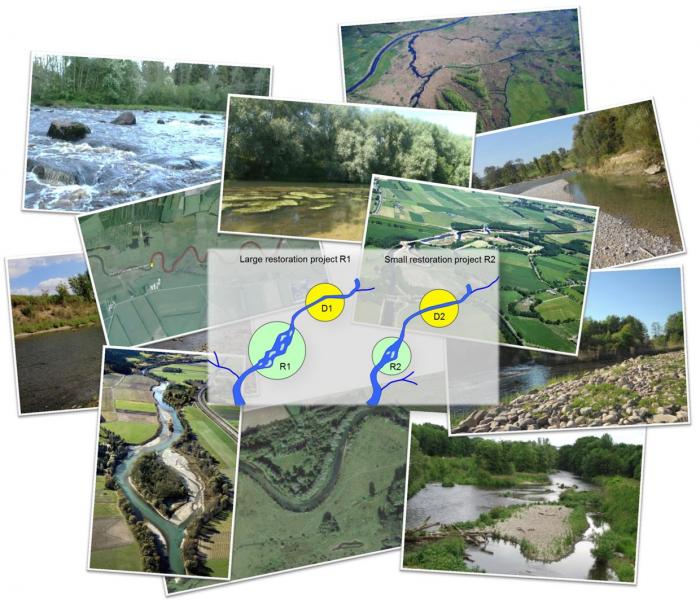In the context of REFORM WP4, we compiled a harmonized dataset on the effects of hydromorphological river restoration measures on a broad range of response variables including habitat composition in the river and its floodplain, three aquatic and two floodplain-inhabiting organism groups, as well as food web composition and aquatic land interactions as reflected by stable isotopes. Additional data on factors potentially constraining or enhancing the effect of restoration were compiled to identify conditions which favour restoration success. Ten pairs of one large and a similar but small restoration project were investigated to especially address the role of restoration extent for river restoration effects. The restoration effect was quantified by comparing each of the 20 restored river sections to a nearby non-restored, i.e. still degraded section.

Figure 1: General study design of the paired restored sections (Deliverable D4.3 of the REFORM consortium)
Main results and conclusions
Restoration effects differed between organism groups and were highest for ground beetles and macrophytes, moderate for fish, and low for macroinvertebrates and floodplain vegetation (the latter usually also showing high effects but being constrained by agricultural land use in our study)
- More organism groups (aquatic AND semi-aquatic / floodplain inhabiting) should be considered in the monitoring and assessment of river restoration projects.
Restoration had an overall positive effect on hydromorphology, especially on macro- and mesohabitat diversity (e.g. number of islands, bars, pools) but a low effect on microscale substrate composition. Microhabitat diversity was correlated with macroinvertebrate richness and diversity; ground beetle richness was not correlated with habitat diversity but related to specific pioneer habitats.
- Key indicators for identifying restoration success should include parameters at larger spatial scales such as channel adjustments.
- While restoration projects like widening are visually appealing and increase macro- and mesohabitat diversity, they potentially fail to increase microhabitat diversity relevant for macroinvertebrates. It is important to ensure that habitats at relevant spatial scales or processes that create such habitats are restored.
- For some organism groups (e.g. ground beetles), it is more important to re-establish specific pioneer habitats and to restore processes to sustain these habitats over the long-term than to increase the mere number of habitats.
Restoration effects on community structure, traits, and functional indicators were generally more pronounced compared to the effects on species number and diversity.
- Future restoration projects and monitoring studies should focus more on functional aspects (e.g. species traits, community structure) to investigate functional changes caused by river restoration, infer causal relationships, and identify restoration measures with large effects on ecosystem functions.
Restoration effects depended on the effect of restoration on aquatic substrate diversity, were especially high in widening projects and depended less on catchment land use and restored reach length.
- Restoration effects were not mainly limited by land use and might have been rather constrained by the limited species pool available for re-colonization since the organism groups which benefited most also have relatively high dispersal abilities (ground beetles, macrophytes). This clearly merits further investigation since it would need a completely different restoration strategy compared to reach-scale habitat improvements.
- Probably, even the large restoration projects in our study were simply too small to benefit from possible positive effects of restoration extent, an observation which is also supported by other recent studies.
- The high effect of widening projects is consistent with other studies and the widely endorsed assumption that restoring geomorphological processes has a higher effect compared to other measures. Since widening includes a set of measures, it has to be further investigated which specific measures drive the high effects. Besides, these results do not question the use of instream measures. Several other studies reported positive effects of instream measures, while our study had a relatively low number of instream projects and thus a limited universality.
The 20 restoration projects investigated in this study were representing good-practice examples in Northern, Eastern and Central Europe, reflecting the relatively long tradition in river restoration in these regions. Regional differences have to be considered when applying these results to other river types and regions (e.g. large or Mediterranean rivers).
Further links
REFORM Deliverable D4.3. Effects of large- and small-scale river restoration on hydromorphology and ecology
